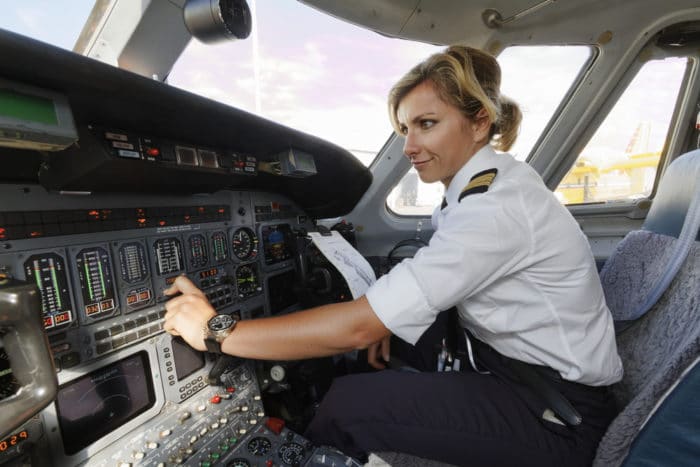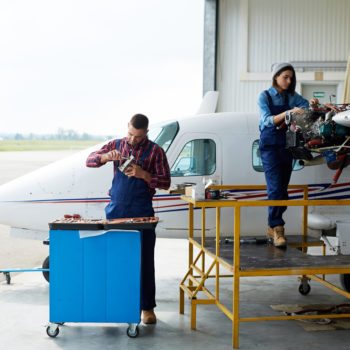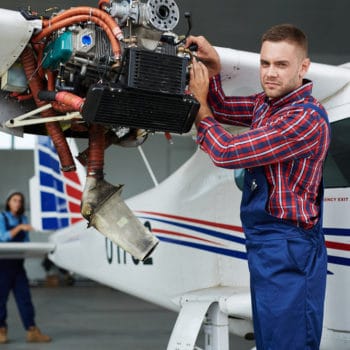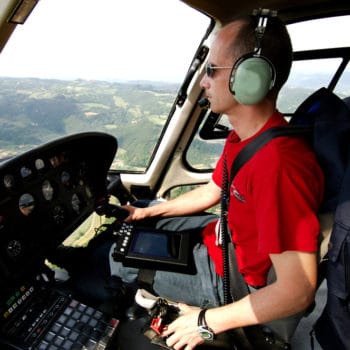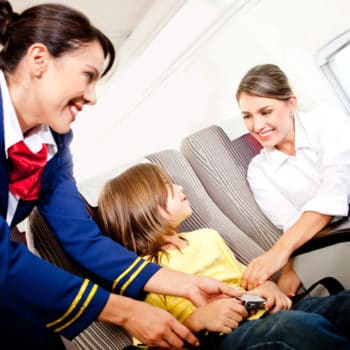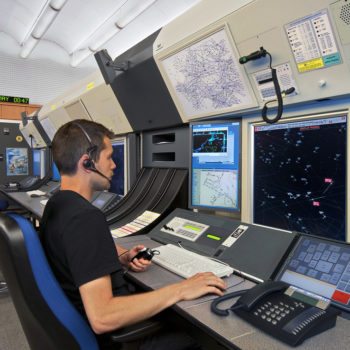Why We Love It
-
$136,400Potential Avg. Salary
-
1.1%Job Growth Rate
-
Growing DemandJob Outlook
-
Don't Take Work HomeCareer Attribute
Airline pilots are the captains in charge of flights for commercial airlines. They manage planes for scheduled fights of people or cargo, coordinate takeoffs and landings, alternate courses due to weather or obstacles, and ensure all maintenance has been conducted before takeoff.
Recommended Schools
What is an Airline Pilot?
The following job responsibilities are common for individuals in airline pilot roles:
- Fly planes for large businesses that transport people and/or cargo
- Ensure that all routine maintenance has been conducted before flight takeoff
- Monitor plane health during flights
- Coordinate with air traffic controllers for flight paths and to coordinate changes in path due to inclement weather or other obstacles
- Communicate with passengers and flight attendants to ensure passenger safety during flights
A Day in the Life
Airline pilots fly planes for major commercial passenger airlines—such as Southwest, Delta, and American Airlines—or for major cargo transport companies like UPS and FedEx. Their role is to ensure planes, cargo, and passengers remain safe during flights. While the primary responsibility of an airline pilot is to fly the plane—taking off, navigating the plane, and landing it—the role entails a lot of additional responsibilities designed to keep all people and objects on a flight safe.
Before a flight, the pilot is accountable for ensuring all routine maintenance has been conducted. This includes ensuring the engine has the proper amount of fuel for the flight and checking to make sure no issues are present that would interrupt proper operation during a flight. During the flight, the pilot may need to change navigation plans to avoid dangerous obstacles like inclement weather, and they must work with air traffic controllers to communicate changes in plans.
Airline pilots are also responsible for communicating with passengers and flight attendants to ensure the safety of everyone on board. The pilot controls the seatbelt sign to keep passengers from standing up during periods of heavy turbulence and may ask the flight attendants to halt operations if standing is unsafe. Additionally, while many modern planes are auto-navigated by computer systems, the pilot is always on standby to take over in case of an issue or emergency.
Typical Work Schedule
The FAA sets strict guidelines for how many hours a pilot is allowed to work and the amounts of time required for breaks between flights. Most pilots work an average of 50 hours a week, though much of that time is spent performing responsibilities other than flying planes. Additionally, most pilots are away from home multiple days a week and stay in hotels in different cities before flying home for breaks.
Airline Pilot Specializations
Airline pilots usually fall into one of two categories: pilot or co-pilot. Pilots are usually the more senior staff members, while co-pilots may have less experience. Both roles are crucial to the safe operation of the plane, and all commercial flights have both a pilot and co-pilot in the cockpit during flights.
Typical Employers
Most airline pilots are hired by the largest commercial airlines: Delta Airlines, United Airlines, Southwest Airlines, and American Airlines. However, smaller airlines also hire pilots and co-pilots, as do major cargo transportation companies like UPS and FedEx.
Recommended Schools
How To Become an Airline Pilot
Most major airlines require their pilots to hold bachelor’s degrees, though the subject and major of the degree is unimportant. More importantly, airline pilots must have the proper licenses granted by the Federal Aviation Administration (FAA). Earning a pilot’s license requires many years of work, so some combine the bachelor’s degree requirement and required training for licensure by pursuing a bachelor’s degree in aviation that results in the proper licensure.
To become licensed, aspiring airline pilots must go through a robust series of training that results in the following licenses and certificates in the order listed: Student Pilot Certificate, Private Pilot License, Instrument Rating, Commercial Pilot License, Multi-Engine Rating, and Airline Transport Pilot Certificate. While aspiring pilots will fly planes and earn flight hours throughout the training, they cannot make money from flights until they earn a Commercial Pilot License that allows them to fly small transport planes and charter flights for profit.
However, to work as an airline pilot, aspiring pilots must continue their training and go on to earn an Airline Transport Pilot Certificate. This provides the proper licensure for pilots to operate major commercial airplanes. In addition to having the proper certification, airline pilots must also have significant experience flying planes as commercial pilots or military pilots. With the proper experience and licenses/certifications, you should be able to qualify for open co-pilot roles for major airlines.
Airline Pilot Salary Data
We’ve provided you the following to learn more about this career. The salary and growth data on this page comes from recently published Bureau of Labor Statistics data while the recommendations and editorial content are based on our research.
National Anual Salary
Low Range
$85,730Average
$136,400High Range
---National Hourly Wage
Low Range
---Average
---High Range
---How do Airline Pilot salaries stack up to other jobs across the country? Based on the latest jobs data nationwide, Airline Pilot's can make an average annual salary of $136,400, or --- per hour. On the lower end, they can make $85,730 or --- per hour, perhaps when just starting out or based on the state you live in.
Salary Rankings And Facts
#21 Nationally for All Careers
Above Average Salary Nationally
Programs and Degrees
Here are the most common degrees for becoming an Airline Pilot. a is usually recommended and specifically a degree or coursework that prepares you for the particular field, see below.
Highest Education Among Airline Pilots
- 2.3% Doctorate
- 11.2% Masters
- 60.8% Bachelors
- 6.8% Associates
- 13.7% College
- 4.8% High School
- 0.5% Less than High School
Job Growth Projections and Forecast
2014 Total Jobs
75,7002024 Est. Jobs
76,500Job Growth Rate
1.1%Est. New Jobs
800How does Airline Pilot job growth stack up to other jobs across the country? By 2024, there will be a change of 800 jobs for a total of 76,500 people employed in the career nationwide. This is a 1.1% change in growth over the next ten years, giving the career a growth rate nationwide of Above Average.
Growth Rankings And Facts
#576 Nationally for All Careers
Above Avg. Growth Nationally
What Companies Employ The Most Airline Pilots
| Industry | Current Jobs | New Jobs Needed | % Increase |
|---|---|---|---|
| Scheduled air transportation | 65,600 | 1,000 | 1% |
| Federal government, excluding postal service | 3,800 | -400 | 0% |
| Support activities for air transportation | 1,400 | 100 | 0% |
